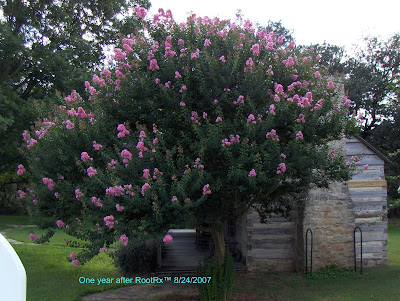Q: What is Root Invigoration™?


A: Root Invigoration™ (Root Rx™, soil reconditioning) is a procedure for dramatically improving the soil structure and organic content in the root zone of a tree or woody plant, and consequently stimulating fibrous feeder root growth. This strikes at the heart of the principle of "going organic from the ground up"(Hendrickson).
The procedure is described in US Patent #6845587 as “A method for improving the rooting soil around a plant by defining an improvement area around the trunk of the plant and utilizing an air excavator to loosen the existing rooting soil in the improvement area, the method also includes treating the existing soil with a treatment to encourage growth of the plant roots in the existing treated soil.”
Root Invigoration was born, like many great inventions, out of frustration. We arborists are always looking at distressed and declining trees that are clearly suffering from poor soil nutrition and severely compacted soil. But how do we alleviate the compaction and increase soil organic content without tearing up the roots?
We can re-pot our house plants, but we can’t re-pot a tree, can we? When we go to plant a vegetable garden, we prep the bed (more on this in another post) by tilling the soil and incorporating compost into the parent soil. But if we till the root zone of a tree, then we’ll do more harm than good by tearing up the vast network of surface roots. We could top-dress, but that surface-applied organic matter really only serves to benefit the turf grass and not the tree. We could apply mulch, but how long is it before that decomposing organic matter becomes incorporated into the compacted soil below to any meaningful degree?
Enter the air excavator. Supersonic air tools like the Air Spade® and the Air Knife® have been around for years. Originally developed in the utility industry as a means of reducing the risk of damage to underground pipes (Nathenson & Jarabak, TCI Magazine, May 2001), air excavators are used in arboriculture for the purpose of excavating buried root collars and exposing roots for surgical work.
So, here we have this problem of poor cultural conditions, and we have this air excavator that we’re using for an entirely different purpose. This is when innovators like E. Thomas Smiley, PhD, of the R. A. Bartlett Tree Research Laboratory in Charlotte , North Carolina Austin , Texas
The results have been astounding. Horticulturists have known for years that improving plant vigor is sometimes a simple matter of improving the cultural conditions. But when we effect a turnaround on a large shade tree, the effects can be quite dramatic.
We haven’t always been able to turn around a tree, however. Sometimes the tree is already too far gone to respond to treatment, and we are compiling field data on species that simply don’t respond under any circumstances. The procedure needs to be done correctly, too. Several years ago I killed a high-dollar Japanese maple by failing to water in the treatment area thoroughly upon completion. But for the most part I don’t recommend the treatment unless I have a pretty good indication that the tree or trees will respond.
The procedure is also a great bed prep, which simply means that we come in and air-till and incorporate organic matter to an entire planting site prior to the installation of the landscape.
I don’t only do this to distressed trees. In fact, as a tree preservationist I would much rather place a healthy tree under my care than one whose problems have already begun to pile up. The procedure is also great for post-transplant establishment and construction damage prevention and mitigation. One of my favorite situations is deck installation. When a deck is built around a tree it is a safe assumption that there will be no access to the root zone for years. What I do is to recondition the soil using the RI technique just prior to the deck being erected. This sets up the tree with plenty of organic matter to sustain its roots for years to come. There is an added benefit to the procedure: the technician performing the procedure can mark places where the posts can be sunk without damaging the roots.
No comments:
Post a Comment